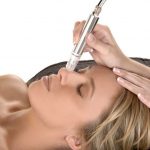What Is Microdermabrasion?
Microdermabrasion is a very popular, machine-assisted skin-exfoliating treatment. Microdermabrasion has advantages of low risk and rapid recovery compared to the other more invasive resurfacing methods such as dermabrasion, chemical peeling, and laser resurfacing. Since microdermabrasion produces only a very superficial depth of skin removal, it works best on improving conditions on the surface of the skin such as early photoaging (sun damage), fine lines, age spots, acne, and superficial scarring, although the results are not dramatic. Although the face is the most common area for microdermabrasion, any skin area, including neck, chest, back, and hands, may be treated. Microdermabrasion is sometimes referred to as “Microderm,” lunchtime peel, Parisian Peel, and Diamond Peel.
Microdermabrasion is a painless, noninvasive, skin-rejuvenation procedure using a combination of a fine abrasive tip or crystals and vacuum suction applied to the skin. There are no needles or anesthetics required for microdermabrasion. The vacuum pressure and speed are adjusted depending on the sensitivity and tolerance of the skin. Microdermabrasion is often compared to the feeling of a cat licking your face, a rough but gentle texture. Typical microdermabrasion sessions can last anywhere from five to 60 minutes. Minimal to no recovery time is required after microdermabrasion and most people immediately return to daily activity after a session. Makeup and nonirritating creams can usually be applied right after microdermabrasion. Studies have shown that microdermabrasion can even temporarily facilitate the absorption of some topical medications by increasing the permeability of the skin.
Microdermabrasion works by removing a few of the top layers of the skin called the stratum corneum. Much like brushing your teeth, Microderm helps to gently remove “plaque” and skin debris. Since human skin typically regenerates at approximately 30-day intervals, skin improvement with microdermabrasion is temporary and needs to be repeated at average intervals of two to four weeks for continued improvement. Multiple treatments in combination with sunscreen, sun avoidance, and other skin-care creams yield the best results.
Who Should Consider Microdermabrasion?
Microdermabrasion is somewhat useful for people with dull or sallow skin, mild acne, acne discoloration, pick marks, and very superficial acne scars. Microdermabrasion may be a good treatment option for patients with superficial skin problems and busy lifestyles who are looking for minimal benefits with virtually no side effects or downtime. Individuals with deeper acne scars may expect a much longer series of treatments or likely benefit from physician-performed surgical dermabrasion, chemical peeling, or laser resurfacing.
How Does Microdermabrasion Work?
A crystal microdermabrasion system contains a pump, a connecting tube, a handpiece, and a vacuum. While the pump creates a high-pressure stream of inert crystals, such as aluminum oxide, magnesium oxide, sodium chloride, and sodium bicarbonate, to abrade the skin, the vacuum removes the crystals and exfoliated skin cells. Alternatively, the inert crystals can be replaced by a roughened surface of the tip in the diamond microdermabrasion system.
Unlike the crystal microdermabrasion system, our diamond-tipped microdermabrasion machine does not produce particles from crystals that may be inhaled into a patient’s nose or blown into the eyes. Therefore our diamond-tipped microdermabrasion is safer for use on areas around the eyes and lips. Generally, the slower the movement of the handpiece against the skin and the more numbers of passes over the skin, the deeper the treatment.
What Ages Are Appropriate for Microdermabrasion?
While there are no specific age or sex restrictions, typically children over age 12 up to adults age 65 can get microdermabrasion. While there is no age maximum, mature skin over age 70 may have slightly higher risks of bruising and skin abrasions. Individuals younger than age 12 may sometimes also receive treatment under the care of a dermatologist or plastic surgeon.
How Often Can I Have Microdermabrasion?
Microdermabrasion can be done as frequently as weekly or up to every eight weeks depending on your skin’s tolerance and desired cosmetic effects. Many people choose to start with weekly treatments for three sessions, then change to a monthly maintenance regimen.
Much like brushing your teeth, microdermabrasion helps to gently remove skin debris. Since human skin typically regenerates at approximately 30-day intervals, skin improvement with microdermabrasion is temporary and needs to be repeated at average intervals of two to four weeks for continued improvement. Usually, multiple treatments (six to 12 sessions) are recommended to see a significant improvement.
What Should I Expect Before, During, and After Microdermabrasion?
Softer and smoother skin that feels fresher and more rejuvenated is the expected outcome after microdermabrasion. Before starting the microdermabrasion treatment, eye protection such as eye pads or goggles may be placed. Often the skin may be prepared and cleaned of makeup and oils. No local anesthetic is required. The skin will be stretched to provide some tension in order to achieve the most effective abrasion and vacuum. The handpiece is moved over the skin with repeated single, smooth passes. Usually, two to four passes per area are sufficient.
Mild pinkness of the skin is the desired outcome and usually resolves within minutes to hours after microdermabrasion. In addition, mild exfoliation of skin may occur as well. Continuously apply moisturizer or ointment if exfoliation occurs. Clients may also experience a mild sunburn-like sensation for a few days. Moreover, liberal application of sunscreen is recommended as photosensitivity may be increased after treatment.
Microdermabrasion may help stimulate the production of collagen, thereby helping skin rejuvenation. As age spots from photoaging and fine lines are diminished, the skin may become softer and smoother.


